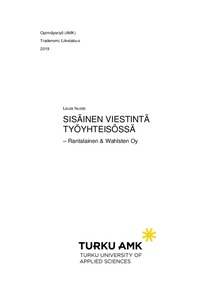Sisäinen viestintä työyhteisössä : Rantalainen & Wahlsten Oy
Nuotio, Laura (2019)
Nuotio, Laura
2019
All rights reserved. This publication is copyrighted. You may download, display and print it for Your own personal use. Commercial use is prohibited.
Julkaisun pysyvä osoite on
https://urn.fi/URN:NBN:fi:amk-2019121226405
https://urn.fi/URN:NBN:fi:amk-2019121226405
Tiivistelmä
Opinnäytetyön aihe on sisäinen viestintä työyhteisössä ja työn toimeksiantajana toimi Rantalainen & Wahlsten Oy. Työn tavoitteena oli selvittää toimeksiantoyrityksen sisäisen viestinnän tämän hetkinen tila ja löytää kehittämistä vaativat kohdat. Opinnäytetyön tarkoituksena oli käytettyjen tutkimusmenetelmien pohjalta luoda viestintäsuunnitelma, jonka avulla toimeksiantoyritys voi kehittää sisäistä viestintää.
Opinnäytetyön teoreettinen viitekehys koostuu viestinnän määritelmästä sekä sisäisen viestinnän teoriaosista. Teoriaosuudessa tarkastellaan sisäistä viestintää Åbergin tulosviestinnän mallia hyödyntäen. Työn empiirisessä osassa tutkimusmenetelminä käytettiin sähköpostikyselyä, haastattelua sekä omia havaintoja. Sähköpostikyselyn avulla kartoitettiin halukkaat tutkimukseen osallistujat, joista satunnaisesti valittuna haastateltiin muutamaa. Haastatteluilla kyettiin syventämään kyselyssä saatuja vastauksia ja keskustelemaan tarkemmin vastaajien kokemuksista. Vastausten ja havaintojen tueksi tehtiin SWOT-analyysi, jonka avulla viestintäsuunnitelma luotiin.
Toimeksiantoyritys vastaajien ja havaintojen mukaan käyttää monipuolisesti erilaisia viestinnän kanavia ja järjestelmiä, mutta sisäinen viestintä vaatii kehittämistä toimiakseen optimaalisesti. Viestintää pitää reaaliaikaistaa ja avoimuutta pitää lisätä, jotta työyhteisö kokee tulleensa kuulluksi. The subject of the thesis is internal communication in the work community, the commissioner is Rantalainen & Wahlsten Ltd. The aim of the thesis was to find out the current state of the internal communication of the commissioning company and to find the areas for improvement. The purpose of this thesis was to create a communication plan based on the used research methods, which will enable the commissioning company to develop internal communication.
The theoretical framework of the thesis consists of the definition of communication and the theoretical parts of internal communication. The theoretical part explored internal communication using the Åberg result communication model. In the empirical part of the thesis the used research methods were email survey, interview and the thesis writer’s own observations. An e-mail survey was used to identify willing participants in the study, of whom a few were randomly interviewed. The interviews helped to deepen the responses to the questionnaire and further discuss the respondents' experiences. The responses and observations were supported by a SWOT analysis which was used to create a communication plan.
According to respondents and observations the commissioning company uses a variety of communication channels and systems, but internal communication requires development in order to function optimally. Communication must be updated in real time and transparency must be increased so that the work community feels it is heard.
Opinnäytetyön teoreettinen viitekehys koostuu viestinnän määritelmästä sekä sisäisen viestinnän teoriaosista. Teoriaosuudessa tarkastellaan sisäistä viestintää Åbergin tulosviestinnän mallia hyödyntäen. Työn empiirisessä osassa tutkimusmenetelminä käytettiin sähköpostikyselyä, haastattelua sekä omia havaintoja. Sähköpostikyselyn avulla kartoitettiin halukkaat tutkimukseen osallistujat, joista satunnaisesti valittuna haastateltiin muutamaa. Haastatteluilla kyettiin syventämään kyselyssä saatuja vastauksia ja keskustelemaan tarkemmin vastaajien kokemuksista. Vastausten ja havaintojen tueksi tehtiin SWOT-analyysi, jonka avulla viestintäsuunnitelma luotiin.
Toimeksiantoyritys vastaajien ja havaintojen mukaan käyttää monipuolisesti erilaisia viestinnän kanavia ja järjestelmiä, mutta sisäinen viestintä vaatii kehittämistä toimiakseen optimaalisesti. Viestintää pitää reaaliaikaistaa ja avoimuutta pitää lisätä, jotta työyhteisö kokee tulleensa kuulluksi.
The theoretical framework of the thesis consists of the definition of communication and the theoretical parts of internal communication. The theoretical part explored internal communication using the Åberg result communication model. In the empirical part of the thesis the used research methods were email survey, interview and the thesis writer’s own observations. An e-mail survey was used to identify willing participants in the study, of whom a few were randomly interviewed. The interviews helped to deepen the responses to the questionnaire and further discuss the respondents' experiences. The responses and observations were supported by a SWOT analysis which was used to create a communication plan.
According to respondents and observations the commissioning company uses a variety of communication channels and systems, but internal communication requires development in order to function optimally. Communication must be updated in real time and transparency must be increased so that the work community feels it is heard.
